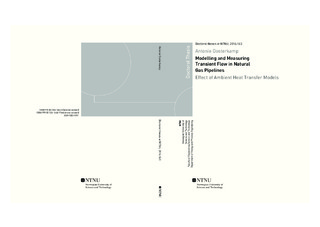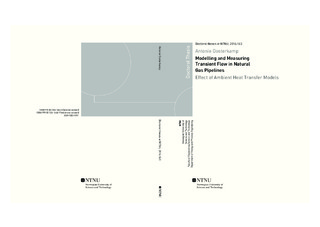| dc.contributor.advisor | Ytrehus, Tor | |
| dc.contributor.advisor | Johansen, Stein Tore | |
| dc.contributor.advisor | Langelandsvik, Leif Idar | |
| dc.contributor.author | Oosterkamp, Antonie | |
| dc.date.accessioned | 2016-07-11T12:23:14Z | |
| dc.date.available | 2016-07-11T12:23:14Z | |
| dc.date.issued | 2016 | |
| dc.identifier.isbn | 978-82-326-1665-7 | |
| dc.identifier.issn | 1503-8181 | |
| dc.identifier.uri | http://hdl.handle.net/11250/2396286 | |
| dc.description.abstract | The central question of this thesis is how and to what extent the representation of ambient heat transfer in the calculation models contributes to observed deviations between modelled and measured flow parameters in natural gas transmission. The focus is on the heat transfer occurring with buried pipelines. The research approach was a combination of model studies with a large experimental component.
The first 12 km of an export gas pipeline was instrumented and used for the experimental investigation of heat transfer behaviour and result verification. This pipeline section contains both onshore and offshore sections. A high accuracy model was made. Real data of the gas flow instrumentation present on the pipeline define the fluid conditions at the model boundaries. At an onshore location, the pipeline and surrounding soil was instrumented. Measurements included pipe wall and soil temperatures, soil humidity and meteorological quantities.
A one-dimensional flow model was used to model the gas flow inside the pipe. This model is coupled to three different external heat transfer models of the ambient domain (pipe wall layers and soil) for comparison. These heat transfer models are 1D steady state, 1D radial unsteady and 2D unsteady description of pipe wall layer and soil. Both conduction and convection heat transfer in the soil layers were investigated. The effect of transient boundary conditions on heat transfer rates and flow parameter calculations were quantified. The developed models were used to analyse and understand the experimental data, to study the effect of different external heat transfer models, the relevant importance of different heat transfer modes, and the boundary condition assumptions on the pipe flow calculations.
The thesis addresses the following research objectives:
- The spatial and temporal formulation of the heat transfer problem: how does the choice of external heat transfer model influence the calculation accuracy of the flow parameters during transient flow? To what degree do the different models capture the physics around the pipeline
- Sensitivities for governing parameters: how do key governing ambient parameters like air/seawater temperature, and the thermal properties of the soil affect the calculation accuracy of the flow parameters?
- The effect of ground water convection and ambient boundary conditions on calculating the flow parameters
The model verification, carried out over an extended period, and the sensitivity studies show that including the heat storage term in the ambient model has the biggest impact on the accuracy of the calculated gas temperatures. The accuracy of gas pressures is much less sensitive for the choice of heat transfer model. A large improvement in the calculation accuracy of gas temperatures is obtained when using an unsteady heat conduction model representing the pipe and soil in radial coordinates. This confirm findings from earlier published work that using such a so called 1D radial unsteady model of the pipe wall and soil, i.e. including the time dependent heat storage term in the governing heat conduction equation, leads to a major improvement of the calculation of gas temperatures during transient flow. This model was compared to the 2D unsteady model, based on coupling a FLUENT model to the flow model. The heat transfer response obtained with the 1D radial unsteady model was found very similar to the geometrically more accurate 2D unsteady model during transient flow conditions.
The 1D radial unsteady model does lead to a gas temperature error in response to the annual periodic ambient temperature. This error was found to be small for a typical export gas pipeline, but can be significant for other configurations. The error introduced by the definition of the ambient soil surface boundary condition was also found to be small compared to the choice of heat transfer model.
The results show that the gas temperature is sensitive to the values of soil thermal conductivity, inner film coefficient and seawater temperature during transient flow. The soil surface boundary conditions have a smaller influence. The sensitivity for the governing parameters of the heat transfer model is strongly dependent on the flow conditions; the resulting deviations in gas temperature are larger during transient flow conditions resulting in large gas temperature fluctuations.
The results also show that the effect of natural convection upon the heat transfer is small for the studied case but that at higher intrinsic permeability of the soil, the role of natural convection will play a significant role. The role of forced convection was found to have a negligible effect.
Soil thermal properties were determined using different methods. The resulting values for thermal conductivity and thermal diffusivity are in agreement with each other to within the measurement accuracy. The measurements in the soil surrounding the pipe show that the thermal properties are mostly constant in time. Some temporal variations were found, but these were not found to make a significant difference on the resulting calculated heat transfer rates and gas temperatures. The experimental results show that the temporal development of soil temperature profiles around the pipe is asymmetrical when comparing the left and right direction. The soil temperatures under the pipe close to the pipe wall were found to be lower than those above the pipe wall, which is opposite of the expectation with a heat conduction model. Both the use of forced and natural convection heat transfer in the model could not explain this difference, but the asymmetry was found not to affect the heat transfer rates significantly within the accuracy of the measurements and calculations.
Comparison to experimental results during a longer time period, showed that using a 1D radial unsteady model leads to good overall agreement in gas temperature, pressure and pipe wall heat transfer. However, incidental, significant, gas temperature and pressure deviations still occur in connection with transient flow conditions. A 1D radial unsteady heat conduction model with constant thermal properties, using air temperature as soil surface boundary condition, will for most practical purposes satisfactorily approximate the more complex physics of the heat and mass transfer in the soil in response to the gas temperature fluctuations and the ambient parameters. | nb_NO |
| dc.language.iso | eng | nb_NO |
| dc.publisher | NTNU | nb_NO |
| dc.relation.ispartofseries | Doctoral thesis at NTNU;2016:163 | |
| dc.relation.ispartofseries | | |
| dc.relation.haspart | Paper a: Helgaker, Jan Fredrik; Oosterkamp, Antonie (Tony); Ytrehus, Tor. Transmission of Natural Gas through Offshore Pipelines - Effect of unsteady heat transfer model. I: MekIT'13 Seventh National Conference on Computational Mechanics | nb_NO |
| dc.relation.haspart | Paper b: Oosterkamp, Antonie; Helgaker, Jan Fredrik; Ytrehus, Tor. Modelling of Natural Gas Pipe Flow with Rapid Transients-case Study of Effect of Ambient Model. Energy Procedia 2015 ;Volum 64. s. 101-110
<a href="http://dx.doi.org/10.1016/j.egypro.2015.01.013 " target="_blank"> http://dx.doi.org/10.1016/j.egypro.2015.01.013 </a>
The article in is reprinted with kind permission from Elsevier, sciencedirect.com | nb_NO |
| dc.relation.haspart | Paper c: Helgaker, Jan Fredrik; Oosterkamp, Antonie (Tony); Langelandsvik, Leif Idar; Ytrehus, Tor. Validation of 1D flow model for high pressure offshore natural gas pipelines. Journal of Natural Gas Science and Engineering 2014 ;Volum 16. s. 44-56
<a href="http://dx.doi.org/10.1016/j.jngse.2013.11.001 " target="_blank"> http://dx.doi.org/10.1016/j.jngse.2013.11.001 </a>
The article in is reprinted with kind permission from Elsevier, sciencedirect.com | nb_NO |
| dc.relation.haspart | Paper d: Sund, Filip; Oosterkamp, Antonie; Hope, Sigmund Mongstad. Pipeline Modeling - Impact of Temperature and Heat Transfer Modeling. I: Proceedings of the twenty-fifth International Ocean and Polar Engineering Conference - ISOPE 2015. International Society of Offshore & Polar Engineers 2015. s. 303-309 - Is not included due to copyright. | nb_NO |
| dc.relation.haspart | Paper e: Oosterkamp, Antonie; Ytrehus, Tor; Galtung, Sondre Tesdal. Effect of the choice of boundary conditions on modelling ambient to soil heat transfer near a buried pipeline. Applied Thermal Engineering 2016 ;Volum 100. s. 367-377
<a href="http://dx.doi.org/10.1016/j.applthermaleng.2016.01.057 " target="_blank"> http://dx.doi.org/10.1016/j.applthermaleng.2016.01.057 </a>
The article in is reprinted with kind permission from Elsevier, sciencedirect.com | nb_NO |
| dc.relation.haspart | Paper f: Oosterkamp, Antonie. Modelling and Measuring Soil Thermal Properties and Pipeline to Soil Heat Transfer of a Natural Gas Pipeline - Is not included due to copyright | nb_NO |
| dc.relation.haspart | Paper g: A.Oosterkamp, ‘Heat transfer modelling of natural gas pipe flow-effect of yearly ambient temperature cycles - Is not included due to copyright | nb_NO |
| dc.title | Modelling and Measuring Transient Flow in Natural Gas Pipelines: Effect of Ambient Heat Transfer Models | nb_NO |
| dc.type | Doctoral thesis | nb_NO |
| dc.subject.nsi | VDP::Technology: 500::Environmental engineering: 610 | nb_NO |

